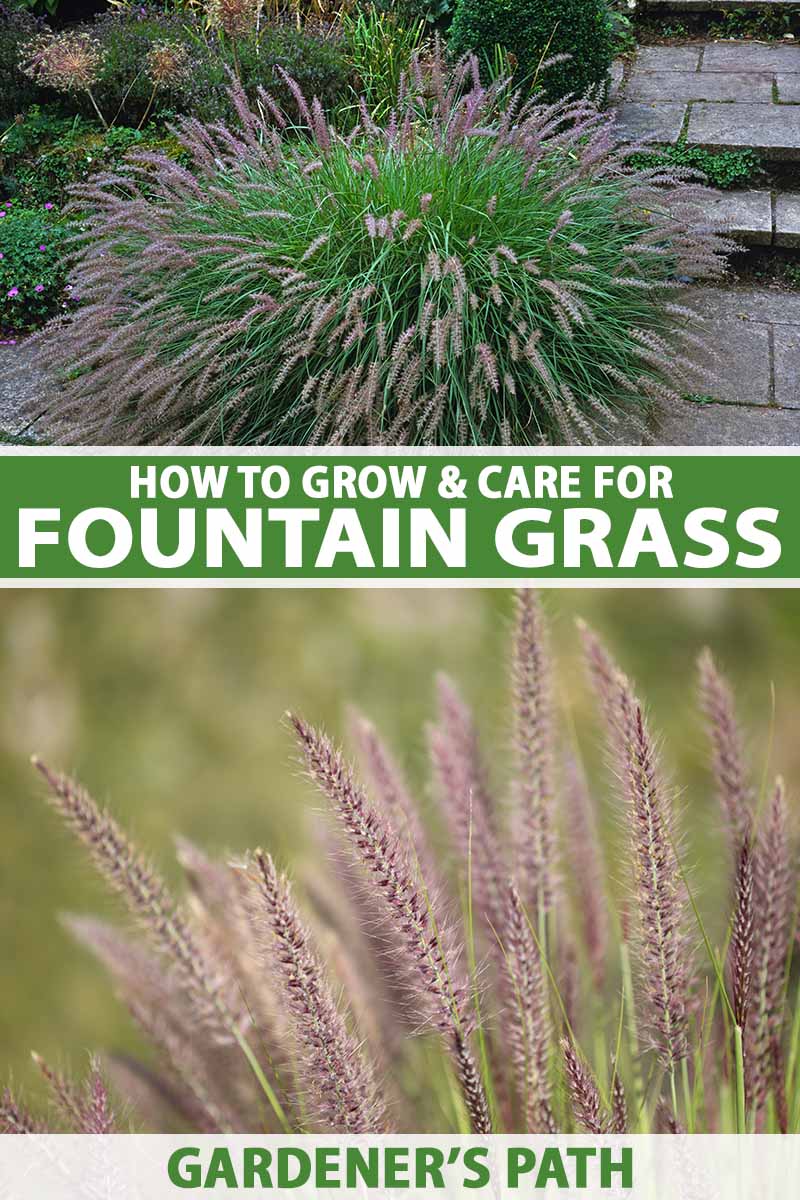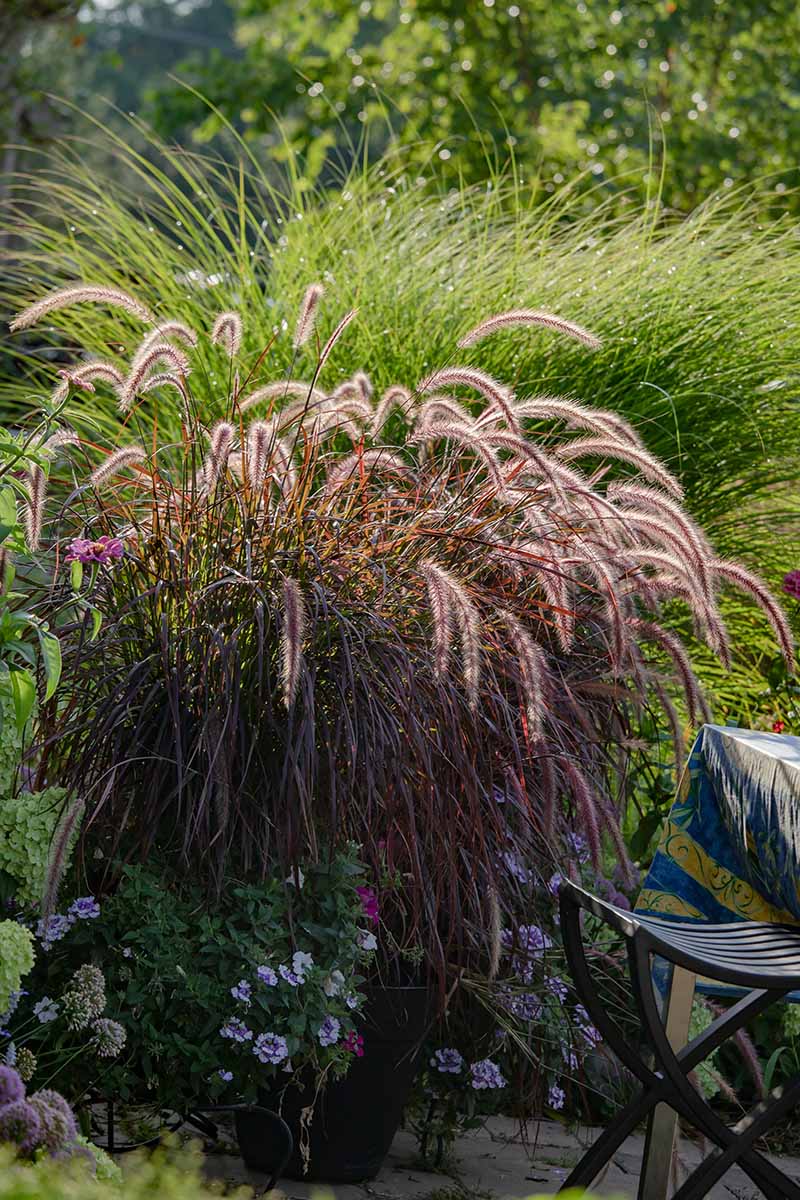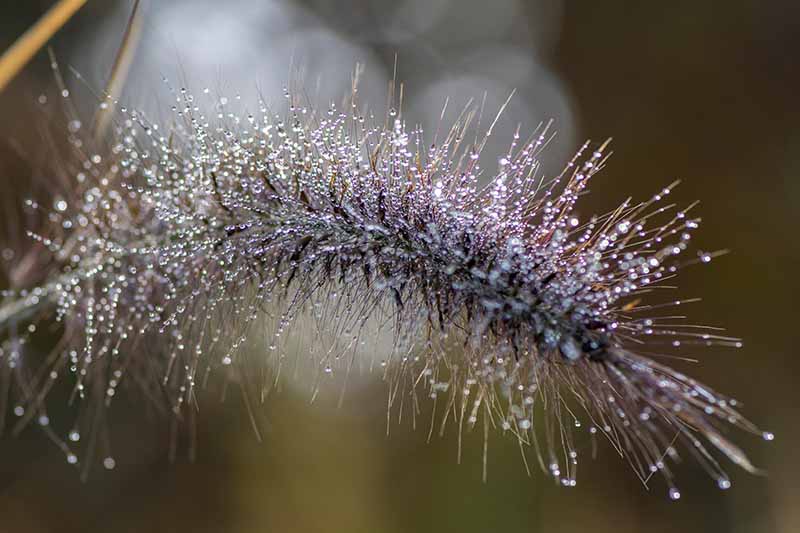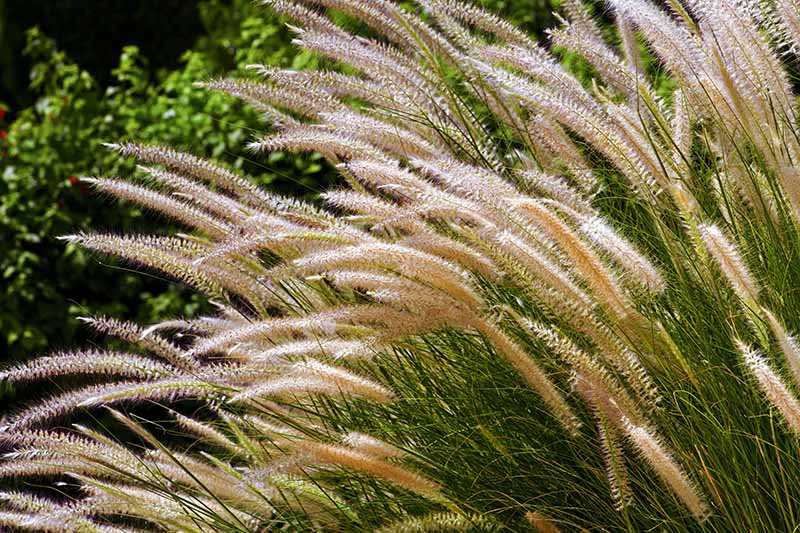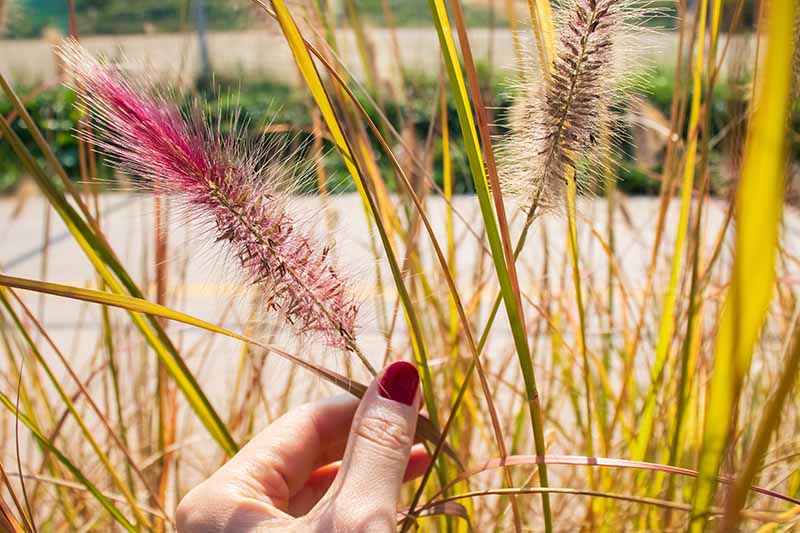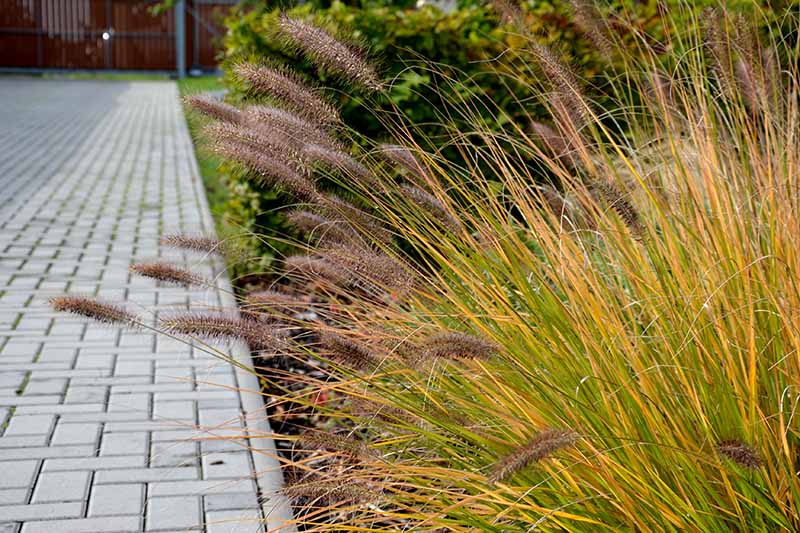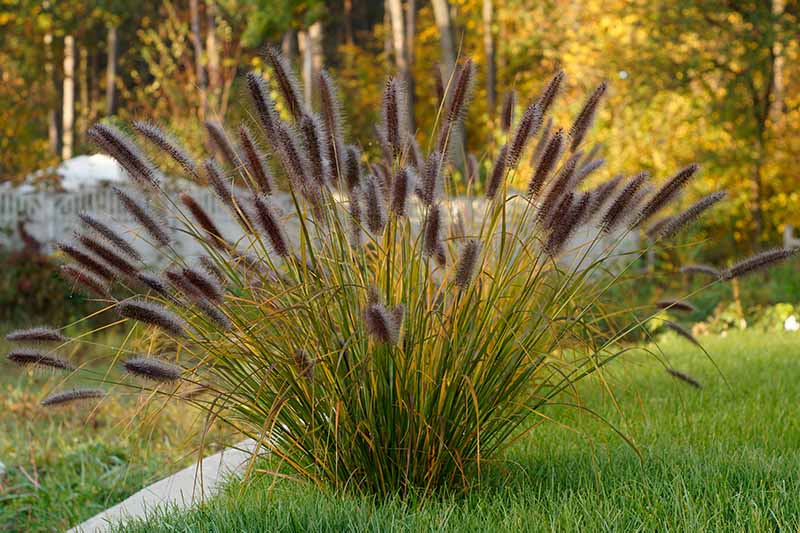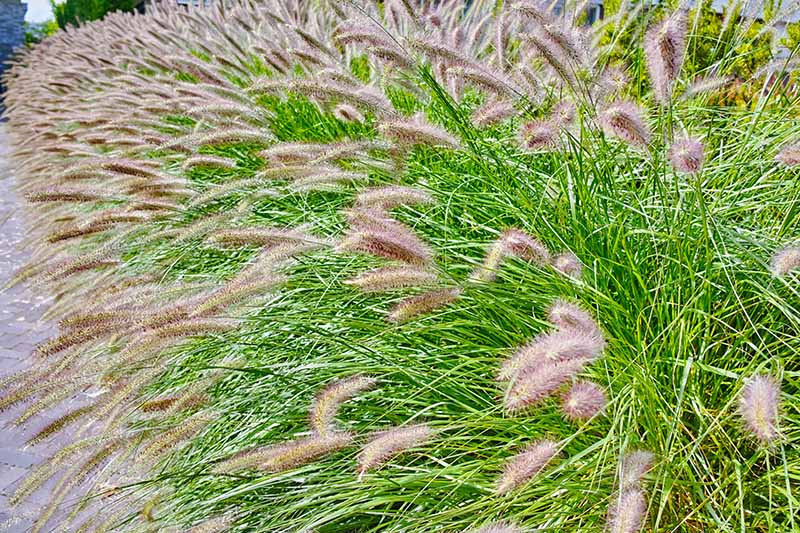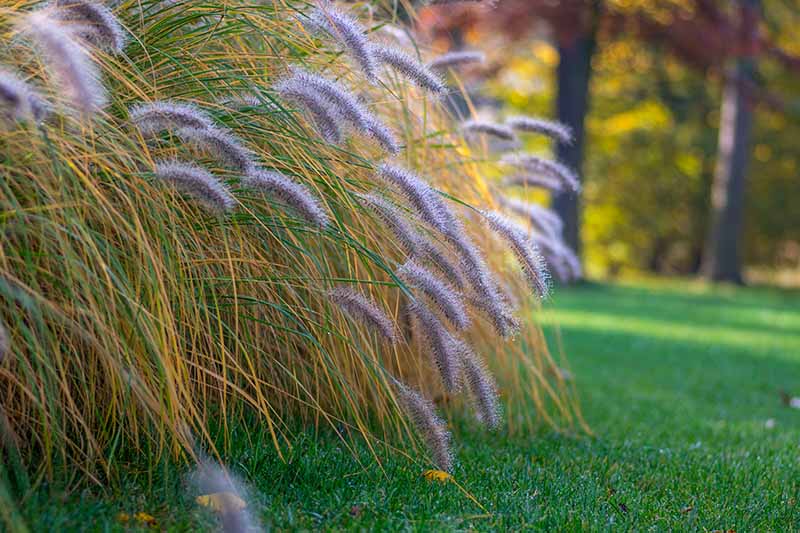A mounding ornamental, Pennisetum is a garden favorite that offers all the beauty of a fountain without the water. It has cascading leaves and bottle brush flower spikes that look much like water bursting out of a fountain, if I do say so myself. We link to vendors to help you find relevant products. If you buy from one of our links, we may earn a commission. Perennial in many places, fountain grass is an attractive option that produces dense, clumping growth. Ready to learn more? Keep reading to learn all the tips you need to grow fountain grass in your landscape.
What Is Fountain Grass?
There are several species in the Pennisetum genus, but a few of the most popular for ornamental use are P. glaucum, P. setaceum, and P. alopecuroides. These plants, which are considered true grasses, have blades that can be either drooping or erect, growing in mounded clumps that are around two to three feet tall. Some popular species, such as P. alopecuroides, have narrow green leaves in the spring and summer that change to a dazzling golden yellow in the fall, and then beige as winter approaches. Nevertheless, the foliage remains attractive throughout the winter months, making this type perfect for all-seasons use. These also produce brush-like flower spikes that vary in color, depending on the type. They may be white, pink, purple, and other colors as well. It is these spikes that serve as the plant’s namesake. They spring from the clump of foliage and look just like water spraying out of a fountain, really! The spikes turn brown as seeds form, and these also hang on until the late fall or early winter, when they shatter and spread.
Cultivation and History
Pennisetum is a large genus that includes a variety of grasses, including two commercial crops – elephant grass (P. purpureum), which is used for biofuel and forage, and pearl millet (P. glaucum), which is edible. Of course, this genus is best known for its gorgeous landscape ornamentals. These plants are native to warm temperate and tropical areas of northern Africa, western Asia, Latin America, and Australia, and are prized for their appearance and hardiness. They typically have bristles, some of which are coated with long, plumelike hairs. It’s these hairs, in fact, that inspired the genus name. The Latin word “penna” means “feather” while “seta” means “bristle.” The genus includes roughly 130 species of plants, and there are several that are perfect for use in landscaping such as the popular pink variety (P. orientale ‘Karley Rose’) as well as purple fountain grass (P. setaceum ‘Rubrum.’) Fountain grass seed was first introduced in the United States as early as 1883. This popular ornamental plant is hardy in many growing zones, so it has consequently been introduced to many parts of the US. Climate can dictate whether certain varieties grow as perennials or annuals. In most parts of the world, it grows easily and peacefully among other plants, and some varieties have naturalized in parts of Europe and North America. However, in some areas, such as the grassland and shrubland regions of Hawaii and the dry grassland habitats of South Africa, fountain grass is actually considered an invasive weed due to its habit of spreading readily in dry habitats where other plants have to work harder to survive.
Propagation
These plants can be grown from seed in some cases, or they may be propagated by division. Potted transplants are also common, in the realm of ornamental grasses. We’ll offer some options later in the article that you might like to look for online, or at your local nursery.
From Seed
There are some kinds of cultivated Pennisetum – such as purple fountain grass, and P. alopecuroides ‘Cayenne,’ ‘Etouffee,’ ‘Hush Puppy,’ ‘Jambalaya,’ and ‘Praline’ – that are marketed as sterile. You won’t be able to propagate these from seed. This is generally considered an advantage, since sterile seed helps to prevent unwanted spread. Note that in some rare cases, gardeners have reported purchasing varieties that were perhaps mislabeled, which were in fact pollinated and then able to produce (unwanted, and self-sowing) fertile seed. Types with fertile seed tend to self-seed readily – something that can border on annoying for gardeners who haven’t planned for this effect! These plants rarely become invasive in cold climates like they can in warmer areas, a definite advantage worth noting. Hybrid cultivars won’t grow true to seed, meaning the plants that result may have unexpected qualities. if you want to grow fountain grass from seed, you may sow in early spring indoors. Fill three- to four-inch pots or 10-by-20-inch trays with a fertile seed-starting mixture. Sow one to two seeds per pot, or space seeds three to four inches apart in trays. Just barely cover the seeds with soil. You can also choose to start seeds outdoors after the last expected frost date in your area, following the same recommendations for spacing as described above in pots or in the ground. Either way, be sure to water the soil evenly until germination occurs. Seedlings should appear within two to three weeks. Once seedlings are established, the soil surface can be allowed to dry out between waterings. When the plants are just two weeks old, it’s safe to move them outside, provided there is no risk of frost in the forecast. Harden them off by putting them outside for just one hour on the first day, then increasing the time spent outside by an hour per day until they can spend the entire day outdoors. Transplant according to the instructions below.
By Division
These plants have a clumping habit and will spread via underground rhizomes. If you choose to divide your mature fountain grass plants to propagate new ones, wait until late winter or early spring. This will give your new plants enough time to become established before the summer heat becomes too intense. The soil should be warm enough to work, and your plants should be dormant or just starting to put on fresh spring growth. Begin by cutting back any existing top growth to about two to three inches above the soil line. Dig up the entire root ball of the plant if you can, using a shovel to work around the edges. In some cases, particularly if your plant is very old or very large, you may not be able to dig it up entirely, and will have to work in sections instead. Feel free to recruit a friend to help! Take divisions only from the outer edge of the root ball to create new plants, and avoid old growth in the center. Use your shovel to cut off rooted pieces that are at least three inches in diameter. Once you have your divisions, replant the parent. You can follow the steps described below to transplant divisions just as you would other transplants, to the same depth that they were growing in the ground previously. Learn more about how to divide perennials in our guide.
Transplanting
When planting transplants, either those that you started indoors yourself or those that you purchased from a nursery, you will start by digging a hole that is twice the width and the same depth as the container that is currently housing your plants. If you have multiple plants, be sure to provide at least three feet of space between them for adequate airflow. Remove them from the containers and gently loosen the roots. Add a bit of compost to the planting hole, then water, and place the transplant in the hole. The crown should be positioned slightly below the soil line. Fill in the rest of the hole with soil, firm it in place, then water deeply.
How to Grow
Plant your fountain grass in a sunny location. It grows best in warm conditions with temperatures ranging from 75 to 85°F, though many cultivars can tolerate much cooler conditions. It prefers full sun but can tolerate partial shade, though it won’t flower quite as well. This grass can be grown in most kinds of soil, but does best in fertile loam. Well-draining soil with a slightly acidic to neutral pH of 6.0 to 7.0 is preferred. Though regular fertilizing is not a requirement when fountain grass is grown in already fertile soils, fertilizer can be applied when new growth appears in the spring. Test your soil prior to planting to get an idea of its nutrient content and pH level. A general-purpose fertilizer applied at regular strength is all you need to get the job done if you do need to fertilize! Water generously for the first three months after planting, providing about one to two inches of water per week if it is not supplied via rainfall alone. You can measure your local precipitation levels using a rain gauge. Once your plant has become established, watering can become less frequent, as fountain grass is quite drought tolerant.
Growing Tips
Plant in full sun.Water weekly until established.Fertilize in the early spring, as needed.
Pruning and Maintenance
Although divisions can be taken once every three years, helping to invigorate the plants, you can prune your plants back in the late winter or early spring regardless of whether you plan to take new divisions. Wear gloves when you do this, as the blades of these plants can be sharp! Fountain grass won’t start growing each year until the soil has warmed up, so you should have time at the end of winter to cut last year’s growth back before new shoots appear. Plants should die back naturally as part of the growing cycle, even in warmer climates where they are grown year-round. Trim plants back to about three to six inches above the ground with a pair of hedge trimmers. To prevent self-seeding, purchase infertile cultivars, or remove seed heads before they shatter and spread their seed around the garden. If you aren’t able to catch them all before they pop, plan to do a little weeding around the garden the following season, to pull up unwanted volunteers. While varieties grown as annuals in cooler zones will die back at the end of the season, you may be able to protect container-grown specimens from the cold to grow them as perennials. Potted plants can be brought indoors in the winter in cooler zones and stored in an unheated basement or other cool location while dormant, before bringing them out again after temperatures warm up.
Cultivars to Select
The following are some of the most popular cultivars of fountain grass to consider, and all of the options that I’ve included in this list are perennial varieties of P. alopecuroides. There are also annual plants in the Pennisetum genus that you can grow, including P. setaceum ‘Rubrum,’ and other species as well.
Managing Pests and Disease
Ornamental grasses such as these are known for being hardy, and they can ward off many common problems. However, there are a few insects and diseases you will want to keep an eye out for. ‘Cassian’ Named after German horticulturist Cassian Schmidt, it is cold hardy to Zone 5. You can find plants for sale in #2 containers at Nature Hills Nursery.
Foxtrot
One of the most cold-hardy cultivars to grow, ‘Foxtrot’ is hardy to Zone 4. It has rosy inflorescences that can also be black. A longtime favorite, this plant grows to about five feet tall, and three to four feet wide. With blades and plumes that sway prettily in even the slightest breeze, its appearance is reminiscent of the smooth, flowing movements of foxtrotting across the dance floor. ‘Foxtrot’ is an unpatented plant selected by Kurt Bluemel, and was formerly recognized as P. alopecuroides ‘Japonicum.’
Hameln
This cultivar is short and compact, growing to just one to three feet tall and wide. It grows best in Zones 4 to 11. ‘Hameln’ With its lovely soft, fluffy plumes and purple flowers, it makes a striking border. It has been granted the Royal Horticultural Society’s Award of Garden Merit.
Little Bunny
‘Little Bunny’ is another compact cultivar to consider, growing to just a foot and a half tall and up to two feet wide. It is one of the best options for growing in partial shade, and is hardy in Zones 5 to 9. ‘Little Bunny’ You can find plants for sale in #1 containers at Nature Hills Nursery.
Moudry
One of the most popular and striking cultivars to consider, ‘Moudry’ is often referred to as black fountain grass. It produces gorgeous dark purple or black flower spikes that appear in late summer to early fall, about three to five weeks later in the season than those of other options. It grows to about two to three feet tall and reseeds with ease. However, it does not usually grow true to seed. Plants are hardy in Zones 5 to 9.
Insects
Most insects and other animals (including deer!) leave fountain grass alone. Be on the lookout for aphids and mites.
Aphids
Aphids (Aphidoidea spp.) cause damage by puncturing the blades to suck out the sap with their tiny mouthparts. These small, often green insects might look harmless, but they can cause the foliage to turn yellow and become weak. You can get rid of aphids by pulling them off your plants by hand, aiming a sharp spray from the hose at them, or applying neem oil. Natural predators such as ladybugs and green lacewings can also be effective.
Mites
Mites (Tetranychidae spp.) are similar to aphids in that they are small and difficult to detect. These nearly microscopic arachnids also suck juices from grass blades, causing the plants to turn yellow. You might not be able to see the mites with your naked eye, but a magnifying glass can help if you know what to look for. In most cases, you can avoid a mite infestation by following the recommendations for watering and fertilization that were mentioned above. Plants that become too dry are targets for mites, who favor low humidity and dusty conditions. You can get rid of a heavy mite infestation in a similar fashion to how you would deal with an aphid problem, hosing down plants, encouraging beneficial predatory insects to take up residence, or employing an insecticidal soap or pyrethrin product.
Disease
As with pests, your best line of defense in preventing most fountain grass diseases is to do whatever you can to keep your plants healthy. These are some diseases you should keep an eye out for.
Rust
Rust (Pucciniales spp.) is a fungal disease that can target all kinds of ornamental plants, including fountain grasses. It causes small yellow or red-orange blisters on grass blades. These areas may enlarge and turn a darker brown in some cases, taking on the appearance of large, streaky blotches. The blades may even wilt and die back. The good news about controlling rust is that you can normally stop its spread by disposing of any affected plant parts. Rust can often be prevented by watering at the base of the plant. Overhead watering can foster overly moist conditions that will encourage the development of fungal diseases like this one.
Powdery Mildew
Like rust, powdery mildew is a fungal disease caused by Golovinomyces orontii that results in powdery-looking blotches to appear on leaves. In severe cases, these growths may cover the entire plant. You may be able to get rid of powdery mildew by applying a fungicide at the first sign of a problem. It’s far easier to prevent, though, as this can be done by planting in full sun. Although fountain grass can tolerate some shade, fungal problems are much more common in dark, humid conditions. Again, watering at the soil level as well as providing proper spacing between plants to increase air circulation can also help to prevent this disease. You can learn more about how to treat powdery mildew in our guide.
Best Uses
Fountain grass is best grown as a specimen plant or focal point in small landscapes. It can even be grown in containers, especially if you’re vigilant about pruning to control its growth. It works well just about anywhere, including in rock gardens, borders (ideally in the front, so it doesn’t become overshadowed by larger plants), around water gardens, or even along the banks of ponds or streams with proper drainage. You can grow it in small groups with other shrubs and perennials to add contrast and texture during all stages of its growth. It can even provide a soft, informal look as an edging plant! Of course, you can always cut the flower spikes to be placed in a vase indoors – and let’s not forget the winter interest offered by this grass, either dried and added to arrangements, or left on the plant until you prune it back in early spring. No matter the season or location, fountain grass is sure to add a special something to your landscape. There are many cultivars for you to choose from, so gardeners in plenty of growing zones should find what they’re looking for with these plants. A consistently easy-care option, fountain grass makes a statement when grown by itself, or with dozens of other plants. Do you grow fountain grass? Which varieties are your favorites? Be sure to share your landscaping ideas for this elegant plant in the comments section below! And if you found this guide helpful, be sure to check out more information on growing ornamental grasses next:
Easy Landscaping with Ornamental Grasses: Simple Tips for Carefree SuccessHow, When, and Why to Cut Back Ornamental Grasses
